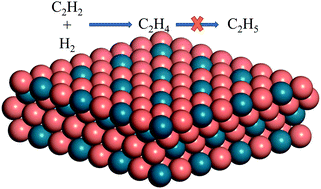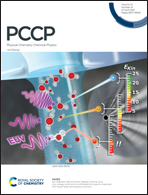Selective hydrogenation of acetylene on Cu–Pd intermetallic compounds and Pd atoms substituted Cu(111) surfaces
Abstract
The selective hydrogenation of acetylene was studied on the ordered Cu–Pd intermetallic compounds (L10-type CuPd, L12-type Cu3Pd, and L12-type CuPd3) and Pd-modified Cu(111) surfaces through first-principles calculations. The catalytic selectivity and activity of Cu–Pd alloy catalysts are closely related to the crystal structure and composition of Cu–Pd intermetallic compounds and the size of Pd ensembles of Cu-based dilute alloy surface for the selective hydrogenation of acetylene to ethylene. Significantly, we found that the ordered Cu–Pd alloy surface containing isolated Pd atoms (i.e., L12-type Cu3Pd(111) surface) is highly efficient for the selective hydrogenation reaction of C2H2 + H2 → C2H4. The contiguous Pd atom ensembles (Pd dimer and trimer) are catalytically active towards C2H2 + H → C2H3 and C2H3 + H → C2H4 reactions than the single Pd atom on a Pd-decorated Cu(111) surface. However, the small Pd ensembles on Cu(111) present a low chemical activity for H2 dissociation compared with the ordered Cu–Pd intermetallic compounds. Our theoretical results provide a strategy of crystal phase and composition control for enhancing the selectivity and activity of Cu–Pd catalysts towards acetylene selective hydrogenation.



 Please wait while we load your content...
Please wait while we load your content...